This post may contain affiliate links. Please read our disclosure policy.
I remember the first day that I walked into my own classroom 17 years ago. I was about to teach 27 first-grade for an entire year, and I couldn’t have been more excited to teach those kids!
Over the next few years, I went from a first-grade teacher to a second-grade teacher. I then became a developmental child therapist, a learning interventionist, and, most importantly, a mom.
Today I’m excited to partner with Reading Eggs to share ideas about how to supplement your child’s online, in-school, homeschool, or unschooled education with our favorite resources that we use at home.
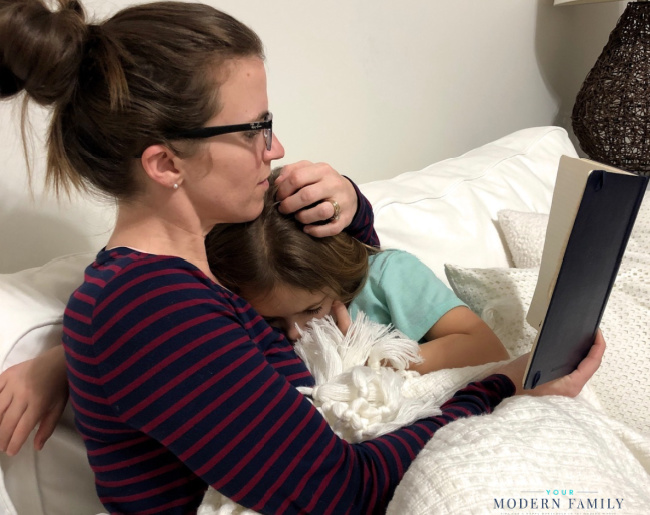
In all of those years, I had never planned on having our children home with me. While I’ve always loved the thought of homeschooling, I valued the schools in our community where I taught, and I wanted our kids to go there. It had never been a plan of ours to bring the kids home for school.
Welcome, 2020: The year of the unexpected.
This year brought many changes, including education. We now have an 8th grader, 6th grader, 4th grader, and 2nd grader learning at home full-time. Each day brings new changes, experiences, and adventures.
Our children are enrolled online, through our public school district, which means they have two hours of live instruction a day. The rest of the day is made up of a few teacher assignments, plus a few lessons from me.

I know that some kids thrive in this type of environment, while others do not. I also know that while some children will push themselves, others will not. We have a mix of all types in our family, which means it is up to me to supplement their lessons. It is up to me to fill in the gaps.
At-Home Lessons
I have to admit that I missed lesson-planning and teaching. I’ve always taught our kids in the summer, but now that I can teach them more often, I’m like a kid in a candy store. Curriculums, lesson plans, manipulatives, centers- all of the things that I missed.
I love having morning meetings with our daughter, using writing charts and flow maps with our sons, singing songs with the kids to help them memorize facts- The list goes on & on.
The thing is, you don’t have to be a teacher to do these things – you don’t have to know how to be a teacher to help your children. You don’t have to love planning lessons. All you have to do is be involved and be willing to learn new ideas and techniques.
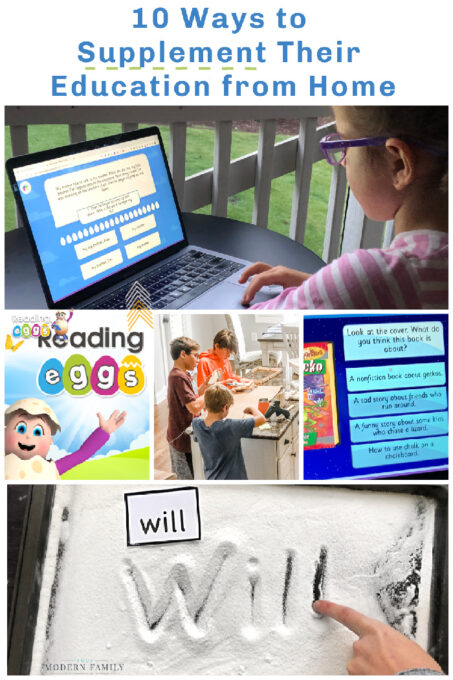
The key to raising amazing children is to be involved. It’s essential to take part in their education, their sport, their friendships, their interests. Merely doing those things will let your children will know that they are loved and valued. The rest of the joy of teaching comes when you realize that the reason the math concept has just “clicked” was because you were there to help. You took part in what they were learning.
With our children being online this year, I wanted to start supplementing their online learning. I knew that they were finishing their entire day’s work in just a couple of hours, leaving them time to work with me on specific skills or subjects. I didn’t want it to be overwhelming or over-the-top, but instead fun and engaging.
Ten ways to supplement their learning at home:
1- Reading Eggs
Reading Eggs is fantastic. Reading is such an important skill, and while our kids love to read, that’s not always enough. I wanted to be sure that we were spending enough time on the essential skills that enable children to become great readers, so we use Reading Eggs.
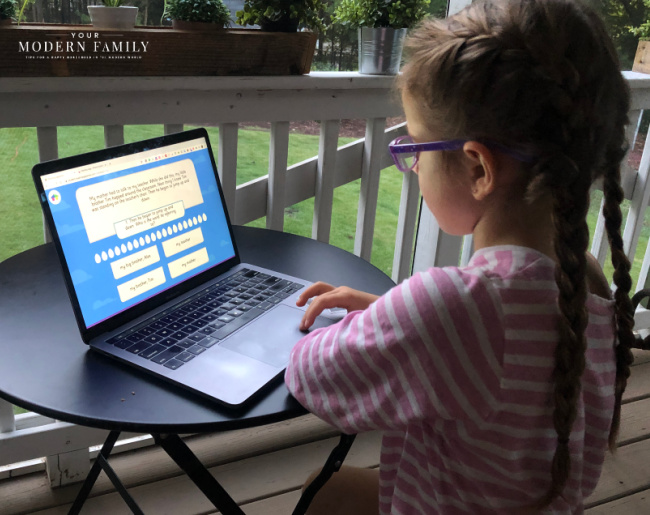
Literacy experts designed it, so I know that they cover all of the crucial areas like grammar, sequencing, fluency, phonemic awareness, vocabulary, comprehension, and more.
The Reading Eggs program teaches kids through lessons, games, repetition, access to their vast library of over 2500 books (visual and audio), and activities to earn rewards (golden eggs) to personalize their avatar and house.
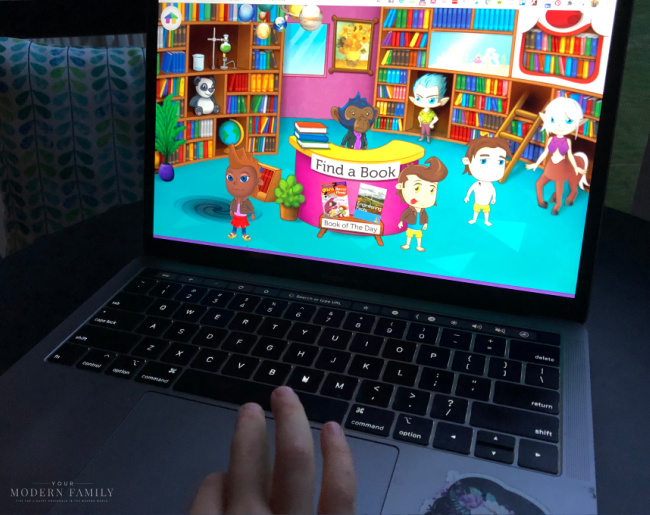
Each of my friends that have tried the program with their kids has loved it. I’m assuming this often happens since there are over 10 million parents signed up for Reading Eggs!
You can join Reading Eggs for free for 30 days!
2- Math Seeds
Mathseeds is an online math program geared towards kids aged 3-9, that can be played on your computer or tablet. They have over 140 lessons! Mathseeds teaches math & problem-solving skills. The skills are mastered through animated online lessons, interactive games, exploration, practice, and fun rewards. I think that our kids think they are just watching a show or playing a game. They don’t feel like they are doing school work.
We started with the month-long free trial. (It’s free for 30 days.) I like that you don’t have to enter any payment information to begin the trial. If you decide that you want it, you can sign up at that time.
Once our trial was up, our kids asked me to extend the membership. They love the characters, the games, watching the acorns hatch after the lessons, etc. . It is fantastic! I feel like it gave our kids such confidence in math, and they grasp the concepts easily.
Plus, it sets them up with a great foundation, which is SO crucial for math!! I’ve told friends about it & they all come back saying the same thing, “I wish we had known about this sooner!”
You can join for a month by using this free-trial URL: https://readingeggs.com/ymf/.
3- Manipulatives
I can remember it like it was yesterday… my dad & brother told me that “X” represented a number. I can also remember being completely lost. Then, my brother said, “X can be a star or a heart. It’s just representing a number.” Still nothing, except MORE confusion.
I tell my kids this story when they are confused about math. I can laugh about it now, but at the time, I didn’t “get it.” I think that to learn; some kids need to “see it” with something real. This is where a manipulative comes into play. Maybe it is in the form of blocks for math or magnetic letters for reading. Whatever it is… you learn by manipulating those objects.
Example: If I had ten blocks, and my math problem said “10 – X = 5″ I could take those ten blocks and take five of them to the side. I could put a small piece of paper over the top of those five blocks, hiding them. On the paper, I would write the letter “X”
Now the only question is, “How many blocks are under the X?” It shows them that the letter X is representing those blocks.
It all boils down to helping kids SEE how things work. Once a number, letter, sound, etc.… makes sense and means something, everything becomes easier. Using blocks to count or practicing spelling by writing the words in sugar are just a few examples.
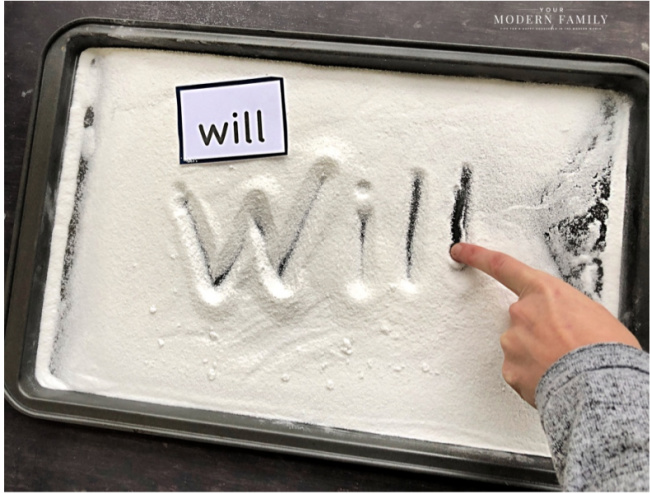
You can also use Play Dough for Learning Letters & Sounds!
We love these Play-Dough Mats (just print them & start playing & learning!)
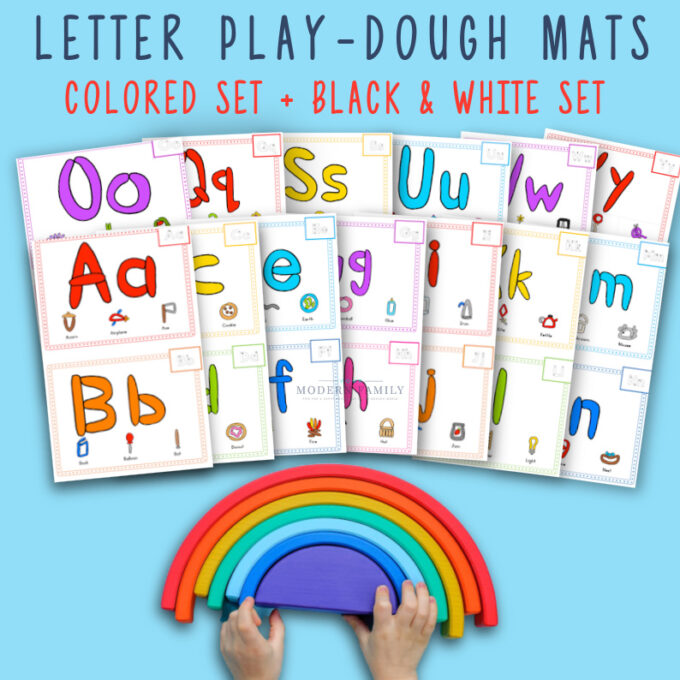
4- DEAR
Drop Everything And Read. Every single day we have 20 minutes of family reading time where we Drop Everything And Read. We all grab our books and head somewhere to read. There is a quote by Emilie Buchwald that says, “Children are made readers on the laps of their parents.”
I believe this is so true.
When we are involved in reading with our children, they learn to love it. For this reason, we read with our children (either listening to them or just being near them so they can see that we are also reading for pleasure).
Usually, our youngest child reads with me on the couch. Our 4th grader follows my husband onto the covered front porch to read. Our 6th grader & 8th grader read on the back screened-in porch or in our living room.
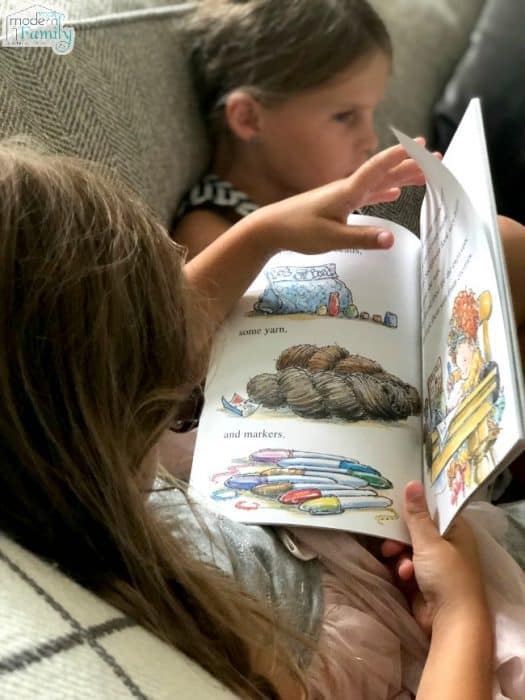
I set a timer for 20 minutes, and we all read. This guarantees that they have read that day, in case they get to bed later than expected. If they get into bed on time, they have another 30 minutes to read, if they are awake enough to do so.
Beau, our 6th grader, usually reads for an hour or more when he gets into bed. At least three days a week, we have to go into his room to remind him to go to sleep- a problem I’m OK with right now! 😉
5- Writing
What better way to practice writing than to write to someone that you love? Our kids each have a journal that they keep in our living room. Every day, they are in charge of writing in someone else’s journal. They write something nice to another sibling.
They also have another journal that I keep. I am in charge of those journals, and I write to the kids every day. Then, they write back. It’s not only a great way to teach them about writing (we talk about grammar, punctuation, etc.… when we read them), but it’s also a great way to learn how to write a letter.
It lets your kids open up to you even more, telling you things that you might not know if you weren’t keeping this journal with them.
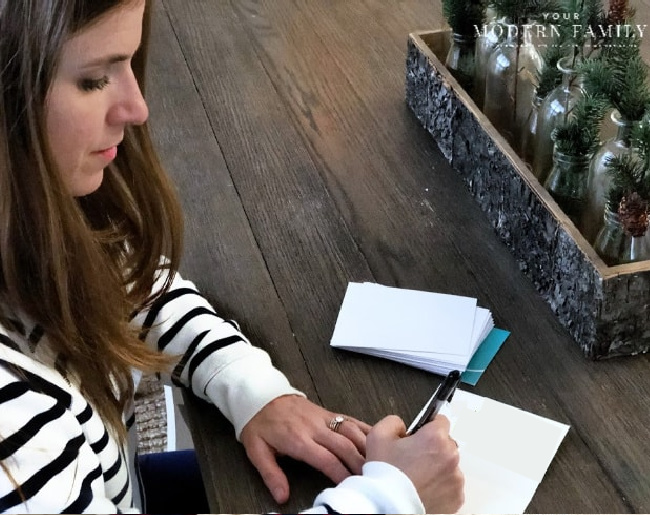
Here’s an example of what I wrote to our daughter yesterday:
“Good morning, Allie!
You were working hard at gymnastics yesterday in your room! I saw that you mastered your hand-stand. Way to go! I think that all of your hard work and practice has made a difference! What do you think you will work on next? I can’t wait to hear all about it!
Love,
Mom
6- Science Lessons
There are so many unique ways to incorporate science into your day! Baking, experiments, and more! This week, our boys (and my nephew) worked on building boats to see which one could float the longest and which ones could be powered to move. They worked on these for hours, tweaking their designs until each child had a floating, moving boat!
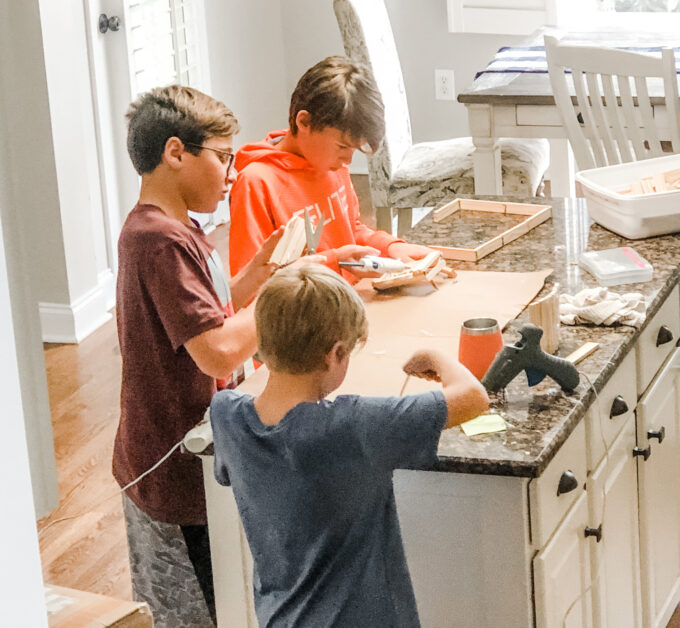
After they finished, we tested many other objects to see if they could float or if they would sink. (Try letting your kids test the floating power of an orange with the peel and then without the peel.)
7- Songs
My mom still knows the cheer that her 8th-grade teacher taught them to remember how to conjugate the verb “to be.” I still sing the colors-song that I learned in my Spanish class in 6th grade.
Songs are easy to understand, and they help you memorize facts. For this reason, I’ve taught our kids skip counting songs for every number up to 12, songs for grammar (ex: prepositions song), songs for history, geography songs, songs for planets (and dwarf planets), and more. If we can’t find one online, we make one up.
8- Country of the Week
This was an idea that we started over the summer. Each Sunday night, one of our kids picks a country they want to learn about for the week. For the entire week, we learn about it through one video each night (we search YouTube for videos about it, virtual field trips, etc.)

We also eat one meal that is popular in that country, listen to one new song each night, and learn a sentence in their language (although even the countries that speak our language have words that we are not familiar with- so there is always something to learn.)
9- Handwriting
I know that handwriting is going away, and typing is here to stay, but I still want our kids to learn how to write well. I have them practice printing until they can do it well (usually the end of 2nd grade), and then they move onto cursive writing.
Our school district did not require children to learn cursive writing in the past, until this year when they brought it back into the curriculum, so I’ve always taught them on my own.
Once they left 2nd grade (at the end of the year), we started with cursive letters. I print off a letter a day, and they work on that letter. Once they have mastered the letters, we move onto small words (am, the, are, at) and then larger words, and finally, sentences.
10- Life Skills
Gone are the days of requiring that our kids take home economics or sewing class. It’s up to us to teach our kids how to sew, bake, deposit checks, etc.… This can be done throughout the day, but I try to set aside a time to work on a skill like this every afternoon.
(Example: Take a week and teach your kids how to sew a button back onto a shirt. Everyone practices that wee until they get it. The following week, work on a new skill.)
Our children also do chores daily, and each week they are in charge of doing their laundry and changing their sheets. Of course, we will help them, but they are responsible for asking for help and trying it independently (once they’ve been shown and taught how to do it several times.)
Remember that you help your child hold the key to their success. Be involved, spend those extra minutes with them, be the positive influence they need, and show them that working hard is a GREAT thing!
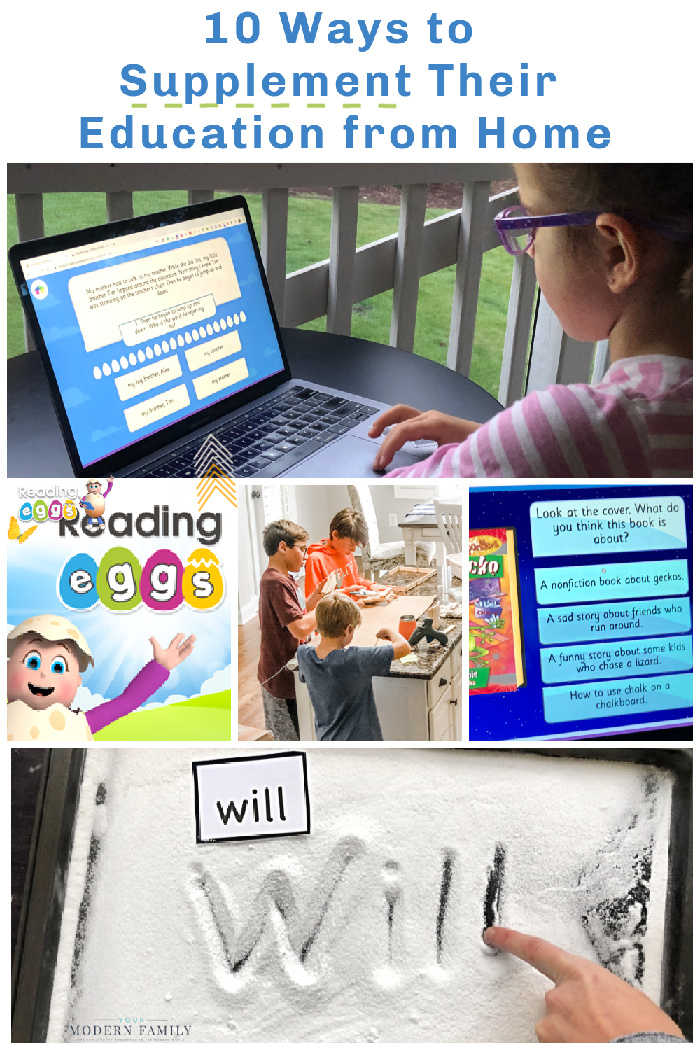














Hi Becky! I’ve been reading your blog for a few years now and love all of your relatable, helpful posts. I’m trying to think of how to incorporate some of these supplemental learning ideas and just healthy family habits. Could you share a rough regular daily schedule just to give an idea of how all of these family goals fit into a normal day? (We’re also doing virtual learning through our public school right now) I know my kids have time that could be better utilized, but I also know free play is beneficial. So, I’m wondering how to offer some of these more big kid activity options I know they’d love.
Hi Emily,
Yep! Let me work on a schedule for you this week. 🙂 We’ve finally gotten into a pretty good routine/schedule, so I’ll write it up either tomorrow or over the weekend & share it with you (I’ll share it as a new post). Check back. 😉